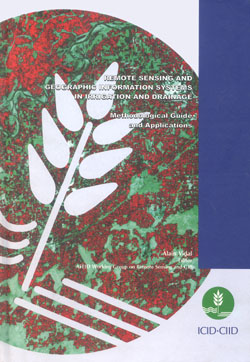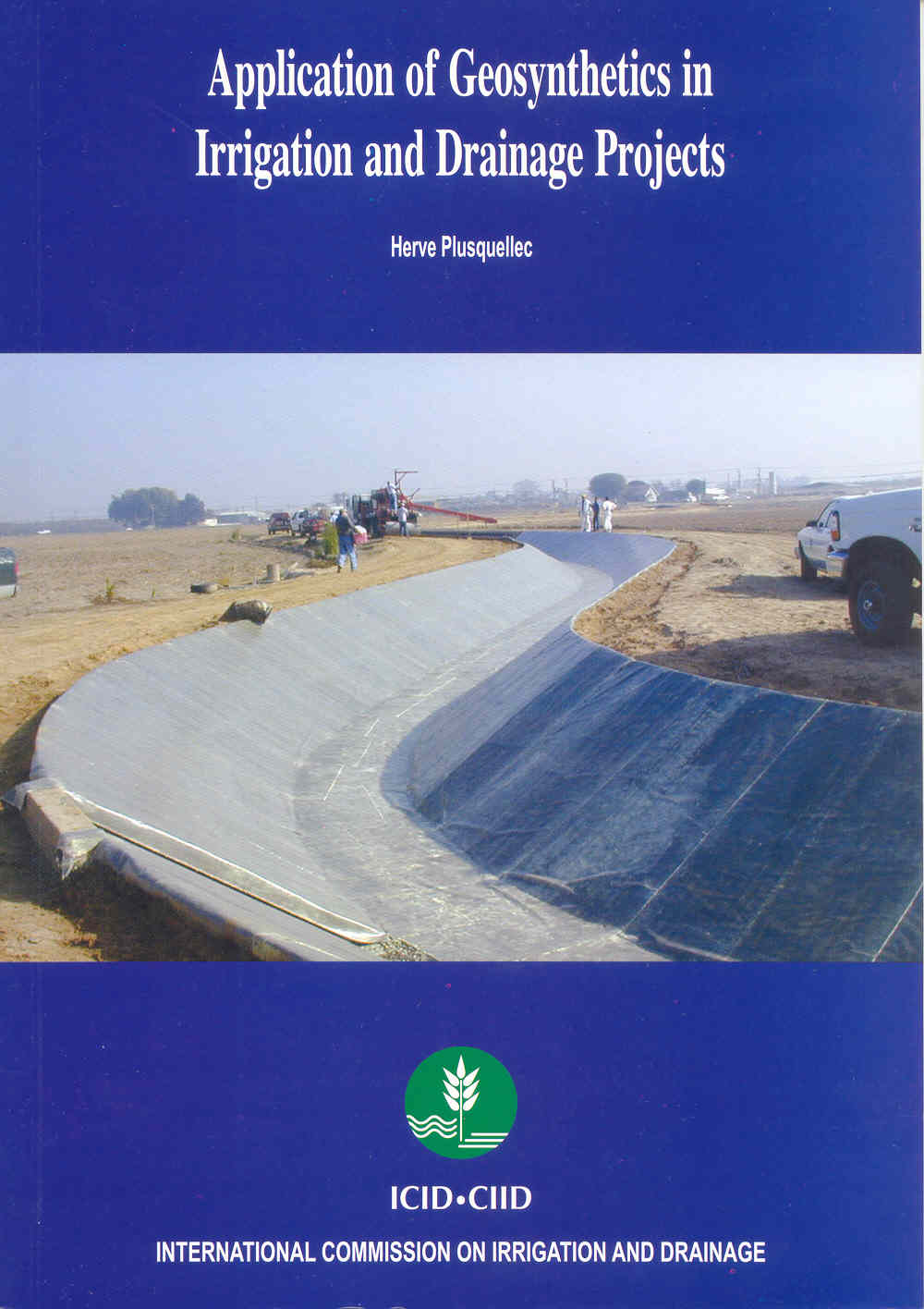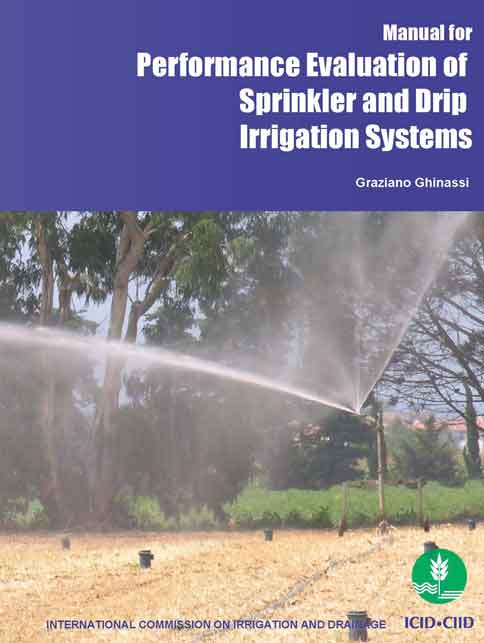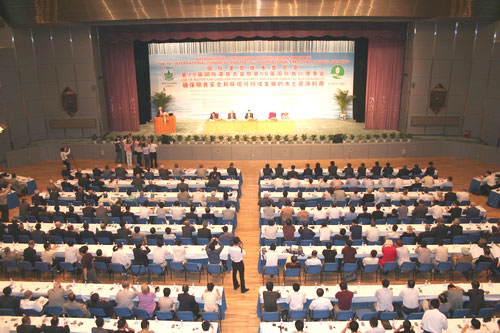
Surface drainage is the diversion or orderly removal of excess water from the surface of land by means of improved natural channels or constructed drains, supplemented when necessary by shaping and grading of land surface to such drains.
Improvements are designed for two purposes: to minimize crop damage resulting from water ponding on the soil surface following a rainfall event, particularly in ground slopes less than 2%, and to control runoff without causing erosion for steeper land slopes. Surface drainage systems are usually applied in relatively flat lands that have soils with a low or medium infiltration capacity, or in lands with high-intensity rainfalls that exceed the normal infiltration capacity, so that frequent waterlogging occurs on the soil surface.
This type of improvement includes: land levelling and smoothing; the construction of surface water inlets to subsurface drains; and the construction of shallow ditches and grass waterways, which empty into open ditches and streams.
Surface drainage systems can be classified into Regular Surface Drainage System and Controlled Surface Drainage System.The regular surface drainage systems, which start functioning as soon as there is an excess of rainfall or irrigation, operate entirely by gravity. They consist of reshaped or reformed land surfaces and can be divided into bedded systems, used in flat lands and graded systems, used in sloping lands.The bedded and graded systems may have ridges and furrows.
The checked or controlled surface drainage systems consist of check gates placed in the embankments surrounding flat basins, such as those used for rice fields in flat lands. These fields are usually submerged and only need to be drained on certain occasions (e.g. at harvest time). Checked surface drainage systems are also found in terraced lands used for rice.
Surface drainage can affect the water table by reducing the volume of water entering the soil profile. Surface drainage improvements require annual maintenance and must be carefully designed to ensure that erosion is controlled. At the same time extensive earthmoving activities are expensive, and land grading might expose less fertile and less productive subsoils. It reduces the agricultural area. Further, open ditches may interfere with moving farm equipment across a field.
Related items you may like



































































































Irrigation
Sources of Irrigation
Irrigation History +
Sources of Irrigation +
IMPROVING SOIL MOISTURE +
Ponds +
Tanks +
Diversion Weirs +
Dams and Reservoirs +
Groundwater +
Conjunctive Water Use +
Wastewater +
Poor Quality Water +
Application of Irrigation water
Canal Irrigation +
Flood Irrigation +
Deficit Irrigation +
Supplemental Irrigation +
Sprinkler Irrigation +
Drip Irrigation +
Lift Irrigation +
Centre Pivot Irrigation +
Tidal Irrigation +
Micro-Irrigation Technologies for Small Holders +
Automatic Irrigation Systems +
Pressurized Irrigation +
Irrigation in Viticulture +
Purpose of Irrigation
Instruments and implements of Irrigation
Pumps +
Centrifugal Pumps +
Submersible Pumps +
Turbine and Jet Pumps +
Conveying Pipes +
Sprinklers +
Drippers +
Canal Automation Systems +
Irrigation Management
Economics of Irrigation System +
I&D System Types +
I&D Investment Functions +
I&D Management Issues +
Participatory I&D Management +
Equity in Irrigation +
Irrigation Services +
Irrigation and environment
Pollution and Irrigation +
Irrigation and Climate Resilience +
Environmental Aspects of Irrigation +
Environmental Impacts of Irrigation +
Green Lawn Irrigation +
Safe Use of Waste Water in Irrigation +
Organic Agriculture +
Soil Health +
Soil Health Management +
Quality of Irrigation Water +
Capacity Development
Drainage
Drainage Types and Systems
Agricultural Drainage +
Field Drainage systems +
Canal Irrigation and Drainage +
Surface Drainage Systems +
Subsurface Drainage +
Mole Drainage +
Bio-Drainage +
Regional Bio-Drainage +
Drainage Issues
- Surface water hydrology
- Subsurface ice, or Interstitial ice
- Drainage area, Drainage basin, River basin, Catchment area, Catchment basin, Catchment, Watershed
- Water parting, Drainage divide, Divide, Watershed divide, Watershed boundary, Topographic divide
- Yield of drainage basin, Annual yield of drainage basin
- Interflow, Subsurface runoff
- Subsurface flow, or Underground flow
- Drainage modulus, or Drainage coefficient
- Subsurface water, Underground water, or Subterranean water
- Isopiestic line, or Pressure surface contour
- Pressure surface map
- Piezometric surface, or Pressure surface
- Water surface (groundwater)
- Phreatic surface
- Potentiometric surface
- Water surface slope
- Surface float
- Subsurface float
- Surface water
- External drainage
- Surface acre
- Surface tension
- Surface tension
- Surface bend, or Free bend
- Topsoil, or Surface soil
- Internal drainage
- Bio-drainage
- Drainage head
- Endogenic drainage
- Allogenic drainage
- Endoreic drainage
- Areic drainage
- Exoreic drainage
- Surface curves
- Surface area of reservoir, or Maximum water surface area
- Water surface
- Normal water surface elevation, Normal water level, Conservation water level, Storage level, Normal pool level, or Conservation storage level
- Drainage gallery
- Drainage wells
- Horizontal drainage blanket, Pervious blanket, or Drainage filter
- Composite surface of failure
- Critical circle, or Critical surface
- Line of seepage, or Phreatic surface
- Soil classification systems
- Hydraulic rollers, Circular roller, Elliptical roller, Vertical roller, Horizontal roller, Inclined roller, Submerged roller, or Surface roller
- Surface type fixed-wheel gate
- Friction drag, Skin friction, or Surface drag
- Top width, or Surface width
- Natural surface line
- Natural surface level, or Ground levels
- Transition-curve length, Transition face length, Transition surface length, or Curved transition length
- Cross-drainage work, or Drainage crossing
- Level crossing, or Level drainage device
- Syphon aqueduct, Drainage syphon, Cross drainage culvert
- Drainage overpasses
- Venturi flume drainage crossing
- Straight (line, surface) sharp cut-water, Equilateral cut-water, or Sixty degree straight sharp cut-water
- Drainage culvert, or Supply culvert
- Integrated production systems
- Cross drainage
- Inverted drainage well, or Disposal well
- Free surface
- Equipotential surface
- Seepage surface
- Depleted pressure surface
- Depleted phreatic surface, or Depleted water table
- Isobath of the piezometric surface
- Fluctuation of the piezometric surface
- Cycle of the piezometric surface fluctuation
- Surface irrigation
- Irrigation through buried drains, Irrigation-drainage, or Vallenhove process
- Surface drip irrigation
- Surface filtration
- Surface runoff
- Drainage
- Drainage channel
- Artificial drainage
- Lowland drainage
- Agricultural land drainage
- Drainage system
- Closed-drainage area, Blind drainage area, or Non-contributing area
- Drainage benefit
- Degree of drainage
- Surface water
- Field drainage
- Field drainage system
- Land drainage
- Natural drainage system
- Seepage drainage
- Subsurface drainage system
- Open channel drainage
- Surface drainage
- Surface drains
- Main drainage system
- Drainage fittings
- Drainage pump sump
- Drainage trench
- Drainage head
- Horizontal subsurface drainage system
- Natural drainage or Natural drainage capacity
- Improved drainage or Artificial drainage
- Random drainage system
- Surface inlet
- Trenchless drainage
- Open-channel drainage
- Convergent drainage pattern
- Natural drainage systems, or Random drainage systems
- Cutoff drainage system, or Intercepting drainage system
- Herringbone drainage system
- Gridiron drainage system
- Double-main drainage system
- Composite drainage system
- Grouping drainage system
- Zigzag drainage system
- Surface-cum-seepage drains
- Cross-slope ditch system, or Drainage-type terraces
- Drainage-density
- Drainage pattern
- Superposed drainage, Super imposed drainage or Inherited drainage
- Subsurface drainage, Under drainage, Subsoil drainage, Underground drainage, or Covered drainage
- Relief drainage system
- Convergent drainage system
- Subsurface drain, Under drain, Covered drain, or Buried drain
- Elkington drainage system, Sink-hole drainage
- Rerolle drainage system
- Across-the-slope drainage system, or Keythrope drainage system
- Vertical drainage, or Inverted well
- Mole drainage
- Field surface drain
- Surface drainage system
- Drainage coefficient, Drainage modulus or Drainage design rate
- Drainage design rainfall
- Drainage efficiency
- Drainage season
- Free surface
- Phreatic surface
- Piezometric surface
- Subsurface run-off
- Surface flow
- Surface runoff
- Angular drainage pattern
- Arterial drainage
- Dendrite drainage
- Drainage boards (also called prefabricated drains)
- Slot drainage
- Radial drainage pattern
- Trellis drainage pattern
- Drainage density
- Vertical subsurface drainage system
- Drainage pumping station, Drainage pumping plant
- Surface retarders
- Surface moisture, or Free moisture
- Smoothing cement, or Surfacer paint
- Surface dressing, or Surface treatment
- Pneumatic butyl valve (for pipeline distribution systems)
- Surface erosion
- Surface sealing (of soil)
- Surface creep
- Drainage terrace, Drainage control terrace, Interception and diversion terrace, Runoff control terrace, or Channel terrace
- Biological systems
- Surface dump
- Surface irrigation
- Land drainage
- Design drainage rate
- Soil drainage status
- Excessive drainage
- Imperfect drainage
- Surface water problem
- Water‑gathering surface
- Water neutral surface
- Water‑spreading surface
- Underdrainage
- Singular layout drainage design
- Natural drainage layout
- Composite layout drainage system
- Mole drainage
- Free drainage
- Poor drainage
- Drainage basin
- Hydraulic effectiveness of flood control systems
- Systems analysis, Operational analysis, System engineering, Mathematical modeling, Management science
- Systems compatibility
- Systems engineering
- Systems integration
- Decision Support Systems
- Surface water body
- Subsurface geology











